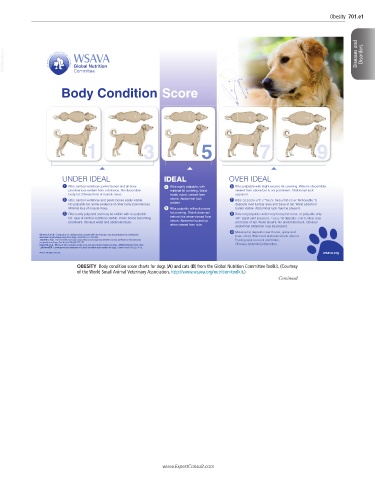Page 1389 - Cote clinical veterinary advisor dogs and cats 4th
P. 1389
Obesity 701.e1
VetBooks.ir Diseases and Disorders
Body Condition Score
5
UNDER IDEAL IDEAL OVER IDEAL
1 Ribs, lumbar vertebrae, pelvic bones and all bony 4 Ribs easily palpable, with 6 Ribs palpable with slight excess fat covering. Waist is discernible
prominences evident from a distance. No discernible minimal fat covering. Waist viewed from above but is not prominent. Abdominal tuck
body fat. Obvious loss of muscle mass. easily noted, viewed from apparent.
2 Ribs, lumbar vertebrae and pelvic bones easily visible. above. Abdominal tuck 7 Ribs
No palpable fat. Some evidence of other bony prominences. evident. deposits over lumbar area and base of tail. Waist absent or
Minimal loss of muscle mass. 5 Ribs palpable without excess barely visible. Abdominal tuck may be present.
3 Ribs easily palpated and may be visible with no palpable fat covering. Waist observed 8 Ribs not palpable under very heavy fat cover, or palpable only
fat. Tops of lumbar vertebrae visible. Pelvic bones becoming behind ribs when viewed from
prominent. Obvious waist and abdominal tuck. above. Abdomen tucked up and base of tail. Waist absent. No abdominal tuck. Obvious
when viewed from side.
abdominal distention may be present.
9 Massive fat deposits over thorax, spine and
German A, et al. Comparison of a bioimpedance monitor with dual-energy x-ray absorptiometry for noninvasive base of tail. Waist and abdominal tuck absent.
estimation of percentage body fat in dogs. AJVR 2010;71:393-398.
Jeusette I, et al. Effect of breed on body composition and comparison between various methods to estimate body Fat deposits on neck and limbs.
composition in dogs. Res Vet Sci 2010;88:227-232. Obvious abdominal distention.
Kealy RD, et al. Effects of diet restriction on life span and age-related changes in dogs. JAVMA 2002;220:1315-1320.
Development and validation of a body condition score system for dogs. Canine Pract 1997;22:10-15.
©2013. All rights reserved. wsava.org
OBESITY Body condition score charts for dogs (A) and cats (B) from the Global Nutrition Committee Toolkit. (Courtesy
of the World Small Animal Veterinary Association, http://www.wsava.org/nutrition-toolkit.)
Continued
www.ExpertConsult.com

